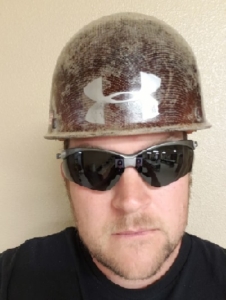Description
At the facility where I work we have a chiller compressor that was a constant problem. It had vibration levels at 1.8 in/s and was constantly being shut down for repair. When we looked at the data we found there to be misalignment issues. Since the alignment reports that where turned in where acceptable we focused in on two things. Thermal growth and resonance issues. We performed a bump test and found there to be a resonant frequency close to running speed of the machine. We installed a tuned mass dampner then rechecked the machine. The misalignment was still present and the amplitude had been lowered but not enough. We then conducted a thorough investigation of the base and structure and found no defects. So with the dampner still installed we ran the machine and took thermal images of it. With these we calculated thermal growth. We also noticed that there was influence from the discharge piping. We then shutdown the machine and installed our laser alignment system and ran the thermal growth program from it. This gave us a better understanding of how the machine was affected in both the horizontal and the vertical directions. We applied what we learned to the next alignment and retested the machine. Now the machine was running at 0.21 in/s and has not been worked on in over a year and a half. I do have data that was collected and reports that where generated to for visual support in a presentation.
Takeaways
1. Better understanding of a complex alignment
2. Understand that compound issues can create problem for seemingly routine maintenance.
3. Provide examples of different methods to obtain good information that they can use to fix the problem.
Bio
 Michael Halstead is a vibration analyst currently working at Searles Valley Minerals in Trona California. He has spent the majority of his nineteen year career in the maintenance field as a welder and mechanic. This experience has served him well as he transitioned into his role as a vibration analyst. He now services over nine hundred machines on a monthly route in addition to finding innovative ways to improve overall plant reliability. Recently becoming a certified category III analyst through the Mobius Institute he is motivated to apply a no stone unturned philosophy while trouble shooting problems with equipment. Staying close to his maintenance roots he is involved with the training of journeyman millwrights, mainly with but not limited to machine alignments. Building professional relationships for learning, teaching and information sharing, are a staple for him as he continues to help build his department to be a world class example.
Michael Halstead is a vibration analyst currently working at Searles Valley Minerals in Trona California. He has spent the majority of his nineteen year career in the maintenance field as a welder and mechanic. This experience has served him well as he transitioned into his role as a vibration analyst. He now services over nine hundred machines on a monthly route in addition to finding innovative ways to improve overall plant reliability. Recently becoming a certified category III analyst through the Mobius Institute he is motivated to apply a no stone unturned philosophy while trouble shooting problems with equipment. Staying close to his maintenance roots he is involved with the training of journeyman millwrights, mainly with but not limited to machine alignments. Building professional relationships for learning, teaching and information sharing, are a staple for him as he continues to help build his department to be a world class example.
